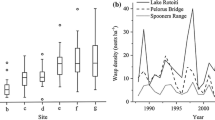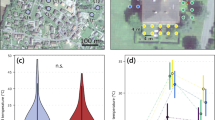Abstract
Disturbance resulting from urbanization is a leading cause of biotic homogenization worldwide. Native species are replaced with widespread non-native species and ants are among the world’s most notorious invaders. To date, all documented cases of ant invasions involve exotic introduced species that are spread around the world by human-mediated dispersal. I investigated the effect of urbanization on the evolution of invasive characteristics in a native ant species, the odorous house ant, Tapinoma sessile (Say). Colony social structure, life history traits, and the spatial pattern of nest distribution were compared by sampling T. sessile across a gradient of three distinct habitats: natural, semi-natural, and urban. Results demonstrate a remarkable transition in colony social and spatial structure and life history traits between natural and urban environments. In natural habitats, T. sessile colonies are comprised of small, monogyne (single queen), and monodomous (single nest) colonies. In urban areas, T. sessile often exhibit extreme polygyny and polydomy, form large supercolonies, and become a dominant pest. Results also suggest that urban T. sessile colonies may have a negative impact on native ant abundance and diversity. In the natural environment T. sessile coexisted with a wide array of other ant species, while very few ant species were present in the urban environment invaded by T. sessile. Habitat degradation and urbanization can lead to extreme changes in social and spatial colony structure and life history traits in a native ant species and can promote the evolution of invasive characteristics such as polygyny, polydomy, and supercolonial colony structure.
Similar content being viewed by others
References
Angilletta MJ Jr, Wilson RS, Niehaus AC, Sears MW, Navas CA, Ribeiro PL (2007) Urban physiology: city ants possess high heat tolerance. PLoS ONE 2:e258
Banschbach VS, Herbers JM (1999) Nest movement and population spatial structure of the forest ant, Myrmica punctiventris (Hymenoptera: Formicidae). Ann Entomol Soc Am 92:414–423
Buczkowski G, Bennett GW (2006) Dispersed central-place foraging in the polydomous odorous house ant, Tapinoma sessile as revealed by a protein marker. Ins Soc 53:282–290
Buczkowski G, Bennett GW (2008a) Seasonal polydomy in a polygynous supercolony of the odorous house ant, Tapinoma sessile. Ecol Entomol 33:780–788
Buczkowski G, Bennett GW (2008b) Aggressive interactions between the introduced Argentine ant, Linepithema humile and the native odorous house ant, Tapinoma sessile. Biol Invasions 10:1001–1011
Cremer S, Ugelvig LV, Drijfhout FP, Schlick-Steiner BC, Steiner FM et al (2008) The evolution of invasiveness in garden ants. PLoS ONE 3:1–9
DeHeer CJ, Backus VL, Herbers JM (2001) Sociogenetic responses to ecological variation in the ant, Myrmica punctiventris are context dependent. Behav Ecol Sociobiol 49:375–386
Diamond J, Case TJ (1986) Overview: introductions, extinctions, exterminations, and invasions. In: Diamond J, Case TJ (eds) Community ecology. Harper and Row, New York, pp 65–79
Fellers JH (1987) Interference and exploitation in a guild of woodland ants. Ecology 69:1466–1478
Fisher BL, Cover SP (2007) Taxonomic descriptions. In: Fisher BL, Cover SP (eds) Ants of North America: a guide to the genera. University of California Press, pp, pp 145–146
Fournier D, Estoup A, Orivel J, Foucaud J, Jourdan H et al (2005) Clonal reproduction by males and females in the little fire ant. Nature 435:1230–1235
Halpern BS, Walbridge S, Selkoe KA, Kappel CV, Micheli F et al (2008) A global map of human impact on marine ecosystems. Science 319:948–952
Herbers JM (1989) Community structure in north temperate ants: temporal and spatial variation. Oecologia 81:201–211
Holway DA (1999) Competitive mechanisms underlying the displacement of native ants by the invasive Argentine ant. Ecology 80:238–251
Holway DA, Suarez AV (2006) Homogenization of ant communities in the mediterranean California: the effects of urbanization and invasion. Biol Conserv 127:319–326
Holway DA, Lach L, Suarez AV, Tsutsui ND, Case TJ (2002) The causes and consequences of ant invasions. Ann Rev Ecol Syst 33:181–233
King JR, Tschinkel WR (2008) Experimental evidence that human impacts drive fire ant invasions and ecological change. Proc Natl Acad Sci USA 105:20339–20343
Kumschick S, Schmidt-Entling MH, Bacher S, Hickler T, Espadaler X, Nentwig W (2009) Determinant of local ant (Hymenoptera: Formicidae) species richness and activity density across Europe. Ecol Entomol 34(6):748–754 doi:10.1111/j.1365-2311.2009.01127.x
Leprieur F, Beauchard O, Blanchet S, Oberdorff T, Brosse S (2008) Fish invasions in the world’s river systems: when natural processes are blurred by human activities. PLoS Biol 6:e28
Lockwood JL, McKinney ML (2001) Biotic homogenization: a sequential and selective process. In: Lockwood JL, McKinney M (eds) Biotic homogenization. Kluwer, New York, pp 1–17
Lowe S, Browne M, Boudjelas S, DePoorter M (2000) 100 of the World’s worst invasive alien species: a selection from the Global Invasive Species Database. The Invasive Species Specialist Group (ISSG) of the World Conservation Union (IUCN), 12 pp
Mack RN, Simberloff D, Lonsdale WM, Evans H, Clout M, Bazzaz F (2000) Biotic invasions: causes, epidemiology, global consequences, and control. Ecol Appl 10:689–710
McKinney ML (2004) Measuring floristic homogenization by non-native plants in North America. Global Ecol Biogeogr 13:47–53
McKinney ML (2006) Urbanization as a major cause of biotic homogenization. Biol Conserv 127:247–260
McKinney ML, Lockwood JL (1999) Biotic homogenization: a few winners replacing many losers in the next mass extinction. Trends Ecol Evol 14:450–453
Menke SB, Booth W, Dunn RR, Schal C, Vargo EL et al (2010) Is it easy to be urban? Convergent success in urban habitats among lineages of a widespread native ant. PLoS ONE 5:e9194. doi:10.1371/journal.pone.0009194
Olden JD, Poff NL (2003) Toward a mechanistic understanding and prediction of biotic homogenization. Am Nat 162:442–460
Olden JD, Poff NL, Douglas MR, Douglas ME, Fausch KD (2004) Ecological and evolutionary consequences of biotic homogenization. Trends Ecol Evol 19:18–24
Palumbi SR (2001) Humans as the world’s greatest evolutionary force. Science 293:1786–1790
Passera L (1994) Characteristics of tramp species. In: Williams DF (ed) Exotic ants: impact and control of introduced species. Westview, Boulder, pp 23–43
Porter SD, Savignano DA (1990) Invasion of polygyne fire ants decimates native ants and disrupts arthropod community. Ecology 71:2095–2106
Rahel FJ (2000) Homogenization of fish faunas across the United States. Science 288:854–856
Reznick DN, Bryga H, Endler JA (1990) Experimentally induced life history evolution in a natural population. Nature 346:357–359
Rooney TP, Wiegmann SM, Rogers DA, Walker DM (2004) Biotic impoverishment and homogenization in unfragmented forest understory communities. Conserv Biol 18:787–798
Ross KG, Keller L (1998) Genetic control of social organization in an ant. Proc Natl Acad Sci USA 95:14232–14237
Sala OE, Chapin FS III, Armesto JJ, Berlow E, Bloomfield J et al (2000) Global biodiversity scenarios for the year 2100. Science 287:1770–1774
SAS Institute (2008) SAS/STAT guide for personal computers, version 9.2. SAS Institute, Cary
Smallwood J, Culver D (1979) Colony movements of some North American ants. J Anim Ecol 48:373–382
Stuble KL, Kirkman LK, Carroll CR (2009) Patterns of abundance of fire ants and native ants in a native ecosystem. Ecol Entomol 34:520–526
Taylor BW, Irvin RE (2004) Linking economic activities to the distribution of exotic plants. Proc Natl Acad Sci USA 101:17725–17730
Thompson RC (1990) Applied myrmecology. In: Vander Meer RK, Jaffe K, Cedeno A (eds) A world perspective. Westview, Boulder, pp 51–67
Vitousek P, Mooney H, Lubchenco J, Melillo J (2007) Human domination of earth’s ecosystems. Science 277:494–499
Acknowledgments
I thank C. Hill, J. Holland, D. Holway, A. Suarez and two anonymous reviewers for comments on an earlier draft of the manuscript, G. DePalma for advice on data analysis, B. Hanstra and J. Hoteling for help locating urban colonies, M. VanWeelden for assistance in the field, and T. Carroll for identifying ants. This study was supported in part by the Industrial Affiliates Program at Purdue University.
Author information
Authors and Affiliations
Corresponding author
Rights and permissions
About this article
Cite this article
Buczkowski, G. Extreme life history plasticity and the evolution of invasive characteristics in a native ant. Biol Invasions 12, 3343–3349 (2010). https://doi.org/10.1007/s10530-010-9727-6
Received:
Accepted:
Published:
Issue Date:
DOI: https://doi.org/10.1007/s10530-010-9727-6




